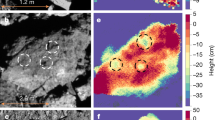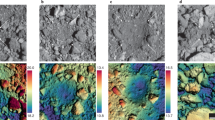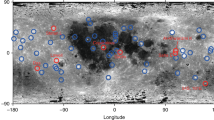Abstract
Small, kilometre-sized near-Earth asteroids are expected to have young and frequently refreshed surfaces for two reasons: collisional disruptions are frequent in the main asteroid belt where they originate, and thermal or tidal processes act on them once they become near-Earth asteroids. Here we present early measurements of numerous large candidate impact craters on near-Earth asteroid (101955) Bennu by the OSIRIS-REx (Origins, Spectral Interpretation, Resource Identification, and Security-Regolith Explorer) mission, which indicate a surface that is between 100 million and 1 billion years old, predating Bennu’s expected duration as a near-Earth asteroid. We also observe many fractured boulders, the morphology of which suggests an influence of impact or thermal processes over a considerable amount of time since the boulders were exposed at the surface. However, the surface also shows signs of more recent mass movement: clusters of boulders at topographic lows, a deficiency of small craters and infill of large craters. The oldest features likely record events from Bennu’s time in the main asteroid belt.
This is a preview of subscription content, access via your institution
Access options
Access Nature and 54 other Nature Portfolio journals
Get Nature+, our best-value online-access subscription
$29.99 / 30 days
cancel any time
Subscribe to this journal
Receive 12 print issues and online access
$259.00 per year
only $21.58 per issue
Buy this article
- Purchase on Springer Link
- Instant access to full article PDF
Prices may be subject to local taxes which are calculated during checkout




Similar content being viewed by others
Data availability
Raw through to calibrated datasets will be available via the Planetary Data System (PDS) (https://sbn.psi.edu/pds/resource/orex/). Data are delivered to the PDS according to the OSIRIS-REx Data Management Plan available in the OSIRIS-REx PDS archive. Higher-level products, for example, global mosaics and elevation maps, will be available in the PDS one year after departure from the asteroid.
Change history
04 April 2019
An amendment to this paper has been published and can be accessed via a link at the top of the paper.
References
Lauretta, D. S. et al. The unexpected surface of asteroid (101955) Bennu. Nature https://doi.org/10.1038/s41586-019-1033-6 (2019).
DellaGiustina, D. N. et al. Properties of rubble-pile asteroid (101955) Bennu from OSIRIS-REx imaging and thermal analysis. Nat. Astron. https://doi.org/10.1038/s41550-019-0731-1 (2019).
Rizk, B. et al. OCAMS: the OSIRIS-REx camera suite. Space Sci. Rev. 214, 26 (2018).
Barnouin, O. S. et al. Shape of (101955) Bennu indicative of a rubble pile with internal stiffness. Nat. Geosci. https://doi.org/10.1038/s41561-019-0330-x (2019).
Nolan, M. C. et al. Shape model and surface properties of the OSIRIS-REx target asteroid (101955) Bennu from radar and lightcurve observations. Icarus 226, 629–640 (2013).
Richardson, D. C., Leinhardt, Z. M., Melosh, H. J., Bottke, W. F. & Asphaug, E. in Asteroids III (eds Bottke, W. F. Jr, Cellino, A., Paolicchi, P. & Binzel, R. P.) 501–515 (Univ. Arizona Press, 2002).
Walsh, K. J. Rubble pile asteroids. Annu. Rev. Astron. Astrophys. 56, 593–624 (2018).
Michel, P., Benz, W., Tanga, P. & Richardson, D. C. Collisions and gravitational reaccumulation: forming asteroid families and satellites. Science 294, 1696–1700 (2001).
Bottke, W. F. et al. Dynamical spreading of asteroid families by the Yarkovsky effect. Science 294, 1693–1696 (2001).
Fujiwara, A. et al. The rubble-pile asteroid Itokawa as observed by Hayabusa. Science 312, 1330 (2006).
Miyamoto, H. et al. Regolith migration and sorting on asteroid Itokawa. Science 316, 1011–1014 (2007).
Hirata, N. et al. A survey of possible impact structures on 25143 Itokawa. Icarus 200, 486 (2009).
Scheeres, D. N. et al. The dynamic geophysical environment of (101955) Bennu based on OSIRIS-REx measurements. Nat. Astron. https://doi.org/10.1038/s41550-019-0721-3 (2019).
Hamilton, V. E. et al. Evidence for widespread hydrated minerals on asteroid (101955) Bennu. Nat. Astron. https://doi.org/10.1038/s41550-019-0722-2 (2019).
Macke, R. J., Consolmagno, G. J. & Britt, D. T. Density, porosity, and magnetic susceptibility of carbonaceous chondrites. Meteorit. Planet. Sci. 46, 1842–1862 (2011).
Ostro, S. J. et al. Radar imaging of binary near-Earth asteroid (66391) 1999 KW4. Nature 314, 1276–1280 (2006).
Bart, G. D. & Melosh, H. J. Using lunar boulders to distinguish primary from distant secondary impact craters. Geophys. Res. Lett. 34, L07203 (2007).
Bischoff, A., Edward, R. D. S., Metzler, K. & Goodrich, C. A. in Meteorites and the Early Solar System II (eds Lauretta, D. S. & McSween H. Y. Jr) 679–712 (Univ. Arizona Press, 2006).
Noguchi, T. et al. Surface morphological features of boulders on Asteroid 25143 Itokawa. Icarus 206, 319–326 (2010).
Molaro, J. L., Byrne, S. & Le, J. L. Thermally induced stresses in boulders on airless body surfaces, and implications for rock breakdown. Icarus 294, 247–261 (2017).
Delbo’, M. et al. Thermal fatigue as the origin of regolith on small asteroids. Nature 508, 233–236 (2014).
Basilevsky, A. T., Head, J. W., Horz, F. & Ramsley, K. Survival times of meter-sized rock boulders on the surface of airless bodies. Planet. Space Sci. 117, 312–328 (2015).
Gladman, B., Michel, P. & Froeschlé, C. The near-Earth object population. Icarus 146, 176–189 (2000).
Graves, K. J., Minton, D. A., Molaro, J. L. & Hirabayashi, M. Resurfacing asteroids from thermally induced surface degradation. Icarus 322, 1–’12 (2019).
Bottke, W. F. et al. The fossilized size distribution of the main asteroid belt. Icarus 175, 111–140 (2005).
Holsapple, K. A. The scaling of impact processes in planetary sciences. Ann. Rev. Earth Planet. Sci. 21, 333–373 (1993).
Holsapple, K. A. & Housen, K. R. A crater and its ejecta: an interpretation of Deep Impact. Icarus 187, 345–356 (2007).
Bottke, W. F., Nolan, M. C., Greenberg, R. & Kolvoord, R. A. Velocity distributions among colliding asteroids. Icarus 107, 255–268 (1994).
Prieur, N. C. et al. The effect of target properties on transient crater scaling for simple craters. J. Geophys. Res. Planets 122, 1704–1726 (2017).
Thomas, P. C. & Robinson, M. S. Seismic resurfacing by a single impact on the asteroid 433 Eros. Nature 436, 366–369 (2005).
Michel, P., O’Brien, D. P., Abe, S. & Hirata, N. Itokawa’s cratering record as observed by Hayabusa: implications for its age and collisional history. Icarus 200, 503–513 (2009).
Tatsumi, E. & Sugita, S. Cratering efficiency on coarse-grain targets: Implications for the dynamical evolution of asteroid 25143 Itokawa. Icarus 300, 227–248 (2017).
Richardson, J. E., Melosh, H. J., Greenberg, R. J. & O’Brien, D. P. The global effects of impact-induced seismic activity on fractured asteroid surface morphology. Icarus 179, 325–349 (2005).
Asphaug, E. Critical crater diameter and asteroid impact seismology. Meteorit. Planet. Sci. 43, 1075–1084 (2008).
Bierhaus, E. B. et al. The OSIRIS-REx spacecraft and the touch-and-go sample acquisition mechanism (TAGSAM). Space Sci. Rev. 214, 107 (2018).
Michel, P. et al. Disruption and reaccumulation as the possible origins of Ryugu and Bennu top shapes. In Lunar Planetary Sci. Conf. 50 abstr. 1659 (2019).
Lauretta, D. S. et al. OSIRIS-REx: sample return from asteroid (101955) Bennu. Space Sci. Rev. 212, 925–984 (2017).
Ernst, C. M., Barnouin, O. S. & Daly, R. T. The Small Body Mapping Tool (SBMT) for accessing, visualizing, and analyzing spacecraft data in three dimensions. In Lunar Planetary Sci. Conf. 49 abstr. 1043 (2018).
Marchi et al. The cratering history of (2867) Steins. Planet. Space Sci. 58, 1116–1123 (2010).
Acknowledgements
This material is based on work supported by NASA under contracts NNM10AA11C and NNH09ZDA007O issued through the New Frontiers Program. M.P. was supported for this research by the Italian Space Agency (ASI) under the ASI-INAF agreement no. 2017–37-H.0. M.D., P.M., and A.R. would like to acknowledge the French space agency CNES. M.D., A.R., P.M. and S.R.S acknowledge support from the Academies of Excellence on Complex Systems and Space, Environment, Risk and Resilience of the Initiative d’EXcellence ‘Joint, Excellent, and Dynamic Initiative’ (IDEX JEDI) of the Université Côte d’Azur. Part of this work was performed at the Jet Propulsion Laboratory, California Institute of Technology, under contract with the National Aeronautics and Space Administration.
Author information
Authors and Affiliations
Consortia
Contributions
K.J.W. led the mapping, analysis and manuscript writing. E.R.J., R.-L.B., O.S.B., E.B.B., H.C.C., J.L.M. and T.J.M. contributed to the mapping, analysis and writing of the manuscript. D.S.L. leads the mission and contributed to analysis and writing. M.D., C.M.H., M.P., S.R.S. and D.T. contributed to mapping and manuscript writing. E.A., K.J.B., C.B.B., W.F.B., C.A.B., K.N.B., B.C.C., M.G.D., D.N.D., J.P.D., C.M.E., D.R.G., A.R.H., R.M., J.M., P.M., M.C.N., M.E.P., B.R., A.R., D.J.S., H.C.C., S.A.S., H.C.M.S. and F.T. all contributed to the mapping, analysis or manuscript writing. The entire OSIRIS-REx Team made the Bennu encounter possible.
Corresponding author
Ethics declarations
Competing interests
The authors declare no competing interests.
Additional information
Publisher’s note: Springer Nature remains neutral with regard to jurisdictional claims in published maps and institutional affiliations.
Rights and permissions
About this article
Cite this article
Walsh, K.J., Jawin, E.R., Ballouz, RL. et al. Craters, boulders and regolith of (101955) Bennu indicative of an old and dynamic surface. Nat. Geosci. 12, 242–246 (2019). https://doi.org/10.1038/s41561-019-0326-6
Received:
Accepted:
Published:
Issue Date:
DOI: https://doi.org/10.1038/s41561-019-0326-6
This article is cited by
-
Measuring the mechanical properties of small body regolith layers using a granular penetrometer
Astrodynamics (2023)
-
Geophysical and orbital environments of asteroid 469219 2016 HO3
Astrodynamics (2023)
-
Inferring interiors and structural history of top-shaped asteroids from external properties of asteroid (101955) Bennu
Nature Communications (2022)
-
A weak and active surface of Bennu
Nature Geoscience (2022)
-
Low surface strength of the asteroid Bennu inferred from impact ejecta deposit
Nature Geoscience (2022)



